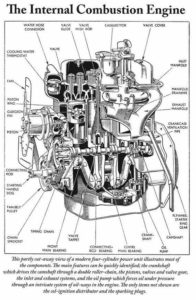People ask me what I think of Question One, which will be on the ballot in the Commonwealth on Nov. 3. My answer is that, while it may not be the most interesting thing to vote on at this election, I think the so-called right to repair does matter to me and the handful of other independent car repair shops this side of the Orleans rotary. But there are other things that matter at least as much to good diagnosis and repair as onboard diagnostics and telematics.
What this is all about is pretty simple. There’s a lot of information stored in your car’s onboard diagnostic system, and car manufacturers would like to control that information. It’s understandable. And I don’t have anything against dealerships. I used to work at one. There’s good support from engineering, and good work gets done there.
It’s just that making that diagnostic information hard to get outside of dealerships would put independent shops at a disadvantage for doing repairs. And getting you to go to the dealership for repairs would help sell new cars, too. Whereas I’m more in the business of helping you keep driving the one you already have.
There are some ads out there about how opening up access to data that is transmitted wirelessly from your car will make you vulnerable to stalking. It’s hard to worry about that when we have satellite radios and we’re all walking around with cell phones anyway.
There is money being spent on both “no” and “yes” advertising. But opposition to Question One is almost entirely funded by dealerships and manufacturers. (They’ve raised over $23 million, about three times as much as the “yes” side, according to a Sept. 12 story in the Boston Business Journal.)
While I know that losing access to that data would gradually weaken my business, I’m not all that afraid of not having access to onboard data. Because if you want to know the truth, it’s usually pretty easy for a mechanic to get to know the condition of your car in low-tech ways. First of all, 90 percent of the things that go wrong are things that are very easy to diagnose. Most brakes, emissions, and other everyday problems are not all that mysterious to solve.
 To dig deeper, the service manuals evolve all the time, so we subscribe to those, paying to get the latest versions online. We also go to classes — or we used to, before Covid-19 — getting up to date on engineering at least once in every non-busy month of the year.
To dig deeper, the service manuals evolve all the time, so we subscribe to those, paying to get the latest versions online. We also go to classes — or we used to, before Covid-19 — getting up to date on engineering at least once in every non-busy month of the year.
And we do spend time listening to what you tell us. The real magic is in replicating the problems and all the funny quirks and squeaks and sounds and lights you tell us about and putting together all sorts of clues.
So, do I want that telematic data? Long haul, I guess so. But the truth is, the way most of us who work on cars solve problems starts with experience and with our senses — what we learn from you and what we see and hear when we get under the hood or take your car out for a test drive.
Do you have questions about auto maintenance or repairs? Sent them to [email protected] and we’ll have our resident mechanic, Kevin Sturtevant, give his diagnosis in a future column.



